Review - (2022) Volume 11, Issue 3
Received: 04-Apr-2022, Manuscript No. jme-22-55587;
Editor assigned: 06-Apr-2022, Pre QC No. jme-22-55587 (PQ);
Reviewed: 20-Apr-2022, QC No. jme-22-55587;
Revised: 25-Apr-2022, Manuscript No. jme-22-55587 (R);
Published:
02-May-2022
, DOI: 10.37421/jme.2022.11.03
Citation: SJ, Horseman, Goede TL, Basri EH and Al Nazawi F, et al. “Game Changing Innovation Ecosystem Development (GIDE) A Systematic Methodology (Meta-Framework) and Conceptual Algorithm Enabling Organizations to Develop, Deploy and Measure Innovation Impact in the VUCA World” J Material Sci Eng 11(2022): 590.
Copyright: © 2022 Horseman S.J, et al. This is an open-access article distributed under the terms of the Creative Commons Attribution License, which permits unrestricted use, distribution, and reproduction in any medium, provided the original author and source are credited.
Organizations have been thrust into a VUCA1 world as an outcome of the global COVID-19 pandemic challenges. VUCA is a worldview that is founded upon environments that are volatile, uncertain, complex and ambiguous (VUCA). Having the ability to be fast, agile and adaptable are the core competencies for VUCA survival, thus making innovation a critical success factor in business sustainability in this new world we are challenged with. Despite this value proposition argument the age-old question of “how can we effectively measure innovation impact?” within a company still exists.
Methodology: This common dilemma presents an opportunity to further critique what innovation metrics and assumptions are more relevant in a new environment such as the VUCA world? Through surveying workforce professionals confirmed that the workforce at large, are also searching for more compelling and systematic metrics that can create and sustain innovation within organizations. In addition to compiling eight years of research that systematically evaluates innovation as it relates to four organizational dimensions (Governance, Culture, Process and Design) in the VUCA world. This real-world case study based on longitudinal actionbased research (N=3567) analyzes how investing and sustaining intellectual human capital through critical systems thinking, mentor-matching and ecosystem development is critical for successful design, development and deployment of innovation within organizations.
Outcome: The outcome of this longitudinal case study is the construction of a meta-framework and algorithm. In applying the combined methodologies of Total Systems Intervention (TSI) through the organizational dimensions of culture and design (soft systems), process and governance (hard systems); a factor analysis algorithm was developed so that organizations can also apply this systematic methodology to position innovation as a business driver and strategic imperative. Therefore, such research outcomes have contributed towards the development of an integrated meta-framework and proposed metric the maturity innovation ecosystem conceptual algorithm which is the business application of GIDE.
Conclusion: Furthermore, an action plan based upon validation research, machine learning simulations and industry case studies is the logical progression of this research work. The objective is to further investigate how GIDE provides a significant knowledge and business contribution for organizations, small-medium enterprises (SME) and startups collectively.
Innovation • VUCA • Impact • Measurement • Systematic • Ecosystem • Meta-Framework • Algorithm
The world at large has been disrupted by the COVID-19 pandemic where we are now living in what is coined the VUCA (volatile, uncertain, complex and ambiguous) world as the “new normal” [1]. Following the rein of the Cold War, the United Stated Army War College developed the concept of VUCA to describe and fully capture the spirit of that era. Decades later, and more so with the COVID-19 pandemic it appears that we are living in a VUCA world, albeit a more advanced version, a VUCA 2.0 of sorts. In such a turbulent world, organizations need to operate in a fundamentally different way to compete and survive, let alone lead and thrive.
As we aspire to adapt to the new normal our world remains volatile, uncertain, complex and ambiguous [2]. This new world requires a new mind set that is both flexible and innovative that embraces digital transformation, technology, and innovation as essential survival tactics [1-2]. Therefore, as validated in the findings of this current research, it suggested that innovation that is the catalyst and driver of this success. In alignment to the purpose of this research paper innovation is defined from the adaptation of Massachusetts Institute of Technology (MIT2) definition stating that innovation (invention commercialization). Based upon the research findings, the authors truly believe that innovation is more than a process, and requires a systematic methodology that can truly invest and synergize innovation through the foundational support of a sustainable and robust ecosystem this is explored further in this section.
The COVID-19 pandemic has highlighted this survival as a necessity no longer a luxury or nice to have. With this necessity in mind, many thought-leaders argue that organizations, especially large ones require imminent transformations to remain relevant and competitive in today’s VUCA world. Today’s organizations are now challenged with an “innovate or perish” dictum that permeates economies and societies of all shapes and sizes and forces them to constantly create and adapt to change at an operational, tactical and strategic level [3]. In the application of the Total Systems Intervention (TSI) framework provide insights into a systematic and sustainable innovation perspective that organizations can successfully navigate solutions to address the innovate or perish conundrum [4]. Firstly, this framework is applied by analyzing the foundations of systematic and sustainable innovation via the TSI’s four dimensions of process, design, culture, and governance (i.e., politics) factors. Furthermore, this postulation is supported with a special focus to the Middle East and Saudi Arabia examples, where the need to innovate is even more paramount [5-7]. Specific examples will be applied through case studies coupled with key quantitative data yielded from various sources [8] that contribute to the proposed conceptual algorithm. This is achieved through the development and deployment of an innovation ecosystem based upon taking great ideas to reality, from lab to market, through a stage-gated Eight Sector Innovation Value Chain© [8]. This methodology is the practical deployment of this game-changing innovation development ecosystem (GIDE) whereas Total Systems Intervention (TSI) and Soft Systems Methodology (SSM) provide the theoretical construct, and the GIDE algorithm is the business application [4-9]. Furthermore, the outcomes demonstrate the potential impact that GIDE provides at an operational, tactical and strategic level across an organization. A discussion of the theoretical and practical implications with an implementation strategy at an organizational level will follow in the next section.
Organizations are multilayered and multifaceted, and any one approach to studying them that isolates a dimension by solely focusing on it at the expense of others, risks becoming a reductionist method that will inevitably overlook critical elements. As such Kozlowski SWJ argues that organizations are best understood as multi-level systems [10]. Approaching the organization as a multilevel system, or system of systems will allow the industry to uncover the links and dynamics between all levels of organizational interaction, which is especially relevant for inherently complex business practices, such as innovation [9]. Mathieu JE Suggests approaching innovation via the lens of critical systems thinking viewed at three levels for a multi-level approach theory, measurement, and analysis [11]. The level of theory refers to the entity that is the focal point of study that is the focus of measurement and analysis, which can vary from individuals to team and from a top-bottom focus to a bottom-up. The measurement level represents the data drawn from the defined focal point that must be aligned with theory level to avoid inaccurate and confusing conclusions. Finally, the analysis level must build on the preceding two and use appropriate techniques and level of emphasis to match the theory and measurements levels [11].
Several empirical studies [12-14] over the last decade continued to prove the value of some form of a multi-level approach to the complex phenomena of innovation by holistically looking at macro and micro factors across theory, measurement and analysis. In truly understanding the complexity of such a phenomenon the organizational dynamics and how-to better cascade innovation in practice successfully at an operational, tactical and strategic level is a critical success factor. To this point this methodology chapter integrates multi-theories of innovation management into one empirical design map (Figure 1) incorporating theory, measurement and analysis underpinning the game changing innovation development ecosystem (GIDE) with the VUCA model, Soft Systems Methodology (SSM) and Total Systems Intervention (TSI). This empirical map will be discussed and explored further throughout this chapter.
Part 1: GIDE empirical map key
A. To strategically evaluate the systematic development and deployment of GIDE through the VUCA: volatile, uncertain, complex and ambiguous worldview.
B. To tactically evaluate the systematic development and deployment of GIDE through the Soft Systems Methodology (SSM).
C. To evaluate at an operational level the systematic development and deployment of GIDE through the Total Systems Integration (TSI) framework.
D. To explore the Meta-Framework=systematic development and deployment of GIDE association between each of the variables.
VUCA world methodology: The why?
The theoretical foundation of the VUCA model explores and explains the fundamental question of why? Why is there a need to incorporate a new approach and worldview on innovation? A worldview that is founded upon environments that satisfies VUCA, especially throughout the COVID-19 pandemic where the environment is extremely volatile. Having the ability to be fast, agile and adaptable are the core competencies for VUCA survival, thus making innovation a critical success factor in business sustainability “innovate or die.” In alignment to the purpose of this research paper innovation is defined from the adaptation of MIT3 definition stating that in novation=invention+commercialization. The age-old question of “how can we effectively measure innovation impact” within a company still exists. This common dilemma presents an opportunity to further critique whether in fact traditional innovation metrics are still relevant in a new environment, such as the VUCA world? Such metrics that evolved and originated from the industrial world include: number of ideas generated, number of patents filed annually, percentage of sales from new products introduced in past (X) years, total R and D budget/percentage of sales, etc., are now challenged for VUCA relevance. Viewing the VUCA world from a global perspective also challenges traditional measures, such as the Global Innovation Index 4 (GII). Approaching this metric from an ecosystem perspective, suggests that innovation is not one index or metric, but instead, could be analyzed and measured from a multisystem methodology. E.g., suggesting that a new framework should be considered based on a new worldview, such as the VUCA lens. Figure 2 suggests how each factor of VUCA could provide insightful context to the COVID-19 pandemic.
VUCA: A call to action during the COVID-19 pandemic
1. Volatility: Where the environmental context (both internal and in a logical or predictable trend or repeatable pattern (e.g., COVID-19 pandemic the world and the healthcare system were unprepared and did not predict the outcome until it was too late)
2. Uncertainty: Where the environmental context (both internal and external) result in major “disruptive” changes that occur frequently and rapidly. In this environment, the past is not an accurate, and identifying “what will come next” was difficult and very surprising (e.g., COVID-19 pandemic the world and the healthcare system were unprepared with the predictor of the future since there were many strains of the virus)
3. Complexity: Where the environmental context (both internal and external) where there are numerous difficult to-understand causes and mitigating factors involved in a problem. The world took on a very reactive approach (e.g., COVID-19 pandemic the world and the healthcare system were unprepared with the predictor of the future since there were many strains of the virus)
4. Ambiguity: Where the environmental context (both internal and external) where the causes and the “who, what, where, when, how, and why” behind the things that are happening are unclear and hard to ascertain (e.g., COVID-19 pandemic the world and the healthcare system were unprepared with the acceptance of the pandemic due to the confusion and often political implications).
The VUCA worldview expressed in context to the COVID-19 pandemic
The VUCA framework highlighted and validated the “why?” there is a need for need for reform in developing and deploying innovation and most significantly measuring the impact of innovation within an organization at a strategic level. The next section explores the question “How is this achieved?” through applying the Total Systems Intervention (TSI) Methodology to this current challenge from a tactical perspecti ve.
Total Systems Intervention (TSI) methodology: The how?
The proposed theoretical framework was constructed dating back to 2012, through a conceptual multilevel approach by leveraging several system frameworks, the TSI at a tactical level, whereas the Soft Systems Methodology (SSM) provides an operational context. The TSI approach first articulated by Flood RL views organizations as whole entities and emphasizes four key organizational dimensions: (1) process, (2) design, (3) culture, and (4) politics/governance based upon their organizational theory perspective [15]. The Process dimension is defined as analyzing flows and control of flows whereas the Design dimension is concerned with the organizational structures and functions in which those processes take place.
The Culture dimension is concerned about mediating behavior aligned with the workforce and management’s relationship to social rules, workplace practice and decision making. Finally, the Politics/Governance 5 dimension focuses on the power dynamics and influences of both workforce and management [4] such an approach is both systematic and holistic. So why is this TSI framework essential within the context of innovation and the VUCA world? The answer to this question is that it shifts the mindset away from a reductionist and isolationist perspective which can result in unexpected, unwanted outcomes and failure to recognize more effective systematic and sustainable solutions to issues as we have seen recently with the COVID-19 pandemic. In applying this TSI mindset effectively suggests in addressing the four dimensions should be based on context and need, adjusting as necessary with no single dimension always dominating [4]. It’s easy, many times natural, to focus solely on one of these four dimensions at the expense of the others. This can lead to what we colloquially call a “management fad” where attention is placed, sometimes to the extreme, on one organizational dimension positioning it as the panacea that will cure all management ills. An example of this reductionist approach is when innovation is defined solely as a “process innovation’ or ‘technology innovation” whereas it should be defined systematically. Therefore, TSI challenges this reductionist thinking and encourages a systematic view of innovation across all systems process+design+governance (policy)+culture. This value proposition argument is put to the test in the methodology section. This methodology provides the foundational theoretical construction of the dependent factors within the conceptual factor analysis algorithm that is described in the analysis section. The next conceptual framework to explore is Soft Systems Methodology (SSM) the “what?” This methodology allows an exploration of the operational context within an organization what needs to get done? SSM is explored in the next section.
Soft Systems Methodology (SSM): The what?
The Soft Systems Methodology (SSM) is an iterative and cyclical learning system investigating the human activity system (HAS) in a seven-step process within the real world and systems world context. Fundamentally, exploring the actors in real world problems and change management situations. SSM thinking stemmed from systems engineering building based on the ten-year action research works of Peter Check land and Brian Wilson. SSM’s main purpose is analyzing complex situations in which the precise definition of problems is a challenge with divergent and conflicting views. Through a structured approach and using systems as an interrogative device among concerned parties (i.e., workforce and management), various human systems can be modeled, which lead to decision makers uncovering optimal solutions [9]. The seven-step methodology consists of addressing a problem statement within the context of the following:
Step 1: analyzing the problem situation unstructured.
Step 2: analyzing the problem situation described within the structured realworld context.
Step 3: describing the problem in the systems world context using root definitions using the CATWOE acronym
C=customers, who are the beneficiaries of the highest-level business process and how this problem affects them?
A=actors, who is involved in the situation and who will be involved in implementing solutions that will impact their success?
T=transformation process, what is the transformation that lies at the heart of the system
W=worldview, what is the big system picture and the macro-impact that this transformation will have at a large scale?
O=owner, who owns this transformation process/situation/problem that is under scrutiny, and what is the role of the owner?
E=environment, what are the specific external factors that will impact the solution? This is represented visually in developing a rich picture
Step 4: within the systems world developing conceptual models in addressing each factor from CATWOE
Step 5: transitions back to the real-world context and compares the conceptual models to reality with a gap analysis.
Step 6: based upon the gap analysis findings each outcome/suggestion then goes through a feasibility study.
Step 7: once validated and concurred the suggested outcomes from step 6 are implemented, being an iterative process the SSM methodology is on continuous learning loop.
Based upon the significant findings in this current research the SSM process provides the foundational theoretical construction of the independent factors within the development of the Eight Sector Innovation Value Chain©. The development and outcome of applying SSM is demonstrated in the methodology section. In summarizing and providing the organizational context of each theoretical framework Table 1 describes how each methodology aligns to the organization using the car metaphor steering wheel (organizational strategic vision forward), gears (organizational tactical navigation of the changing environment), and engine (organizational operational context in deploying the strategy companywide).
| Methodology | Car Metaphor | Asks the question? | Organizational Context |
|---|---|---|---|
| VUCA | Steering wheel | Why? | Strategic |
| TSI | Gears | How? | Tactical |
| SSM | Engine | What? | Operational |
In validating each of the theoretical constructs it is now essential to align the current environment and market dynamics which is the driver of why innovation is critical for the Saudi Arabian markets as a catalyst for Vision 2030’s National Transformation Strategy.
The case for innovation as a key driver of the Saudi national transformation
Since this current research was conducted in Saudi Arabia 6 it is also important to explore the environmental drivers that contributed to the momentum and rationale behind this work and an ongoing study 7. To provide a national context to this research project it is essential to explore the innovation challenges at a macro-level. Saudi Arabia, with its 2030 vision has begun its plan to move away from oil-dependent industries. Similarly, other Middle Eastern producers are looking to diversify to renewables, green and sustainable power [16].
As highlighted before, there are very few remaining industries that are immune to these changes, which require huge capital investments and large, static bureaucratic structures to ensure stability of operations through centralizations and top-bottom planning and decision-making. As the current literature states there are multiple trends that are currently transforming the global oil and gas industry from smart drilling and smart oilfields, to block chain and big data that will enable more agile and efficient operations [7].
This will allow the refunneling of oil from fuel to feedstock - petrochemicals [17].Globally, we are experiencing that the oil and gas industry are likewise not immune with the gig-economy, which is predicted to disrupt industry like all others. The trend being that more oil and gas companies will want to share the risk, so will rely more on joint ventures and temporary workers, while employing onshore technology for office-based workers as opposed to deploying them offshore [17]. The rewards are already being reaped for companies brave enough to embrace the change and step into the future [7].
For example, while average costs have increased by 200%-250% since 2007, it’s estimated that those who optimize multiple organizational levers can achieve up to 50% reduction in offshore drilling costs, which accounts for around 50% of capital spending in exploration and production [7]. These levers include driving learning curves, improving performance culture, and implementing start-up thinking and lean techniques [18].
Suggesting that innovation is a critical success factor in this industry revolution. As seen in the empirical map in Figure 1, these insights are essential components of the systematic innovation metaframework introduced in the coming sections.
Part 1: Empirical map: Game-Changing Innovation Development Ecosystem (GIDE)
Part 1: GIDE empirical map key (Additions: Measurement tools and meta-framework)
A. To strategically evaluate the systematic development and deployment of GIDE through the VUCA world view. Measurement Tool: Environmental impact over time.
B. To tactically evaluate the systematic development and deployment of GIDE through the Soft Systems Methodology (SSM). Measurement Tool: Quantitative rich picture and systems mapping.
C. To evaluate at an operational level the systematic development and deployment of GIDE through the Total Systems Integration (TSI) framework. Measurement Tool: Organizational dimensions score (/5).
D. To explore the Meta-Framework=systematic development and deployment of GIDE association between each of the variables.
The outcome of the literature review is the development of the GIDE empirical map, which demonstrates the operational, tactical and strategic impact with the inter-relationships of the meta-framework synthesis. This synthesis is further explored and discussed in the methodology section.
Based upon the key insights from literature review the theoretical constructs of: VUCA model, both the Total Systems Intervention (TSI) and Soft Systems Methodology (SSM) demonstrates how theory transforms into practice of a new Meta-Framework. Additionally, innovation at a macrolevel is a significant driver of the Vision 2030 strategy. This section will develop these key assumptions further and provide the data tools required to analyze the validity and reliability of applying this Meta-Framework within an organizational context (Figures 3-4 and Table 1).
Theory to Practice-Total Systems Integration (TSI): Tactical application of innovation
The integration of TSI into practice was to first analyze the current thinking among professionals based on the understanding of what critical organizational dimensions are needed to successfully develop and deploy impactful sustainable innovation companywide.
In response to the survey based upon asking 137 professionals the question ‘what organizational systems are the most vital to organizations in sustaining successful innovation development and deployment in their organizations?’ The qualitative definitions were classified as:
• Culture: Systems that support ‘how we get innovation ingrained and viral so it becomes part of the organizational DNA’? (People-soft system 8)
• Policy: Systems that support ‘who enables and champions innovation policies/procedures for the long term’? (Governance-soft system)
• Process: Systems that support ‘what needs to be achieved step by step to take great ideas to reality’? (Methodology hard system 9)
• Design: Systems that support ‘what framework and structure enables the transfer of innovation across the entire organization’? (Technology hard system)
Theory to Practice-Soft Systems Methodology (SSM): Operational application
The integration of SSM into practice was to first analyze the current thinking through applying the seven steps. This outcome is seen in Figure 5 and Table 2. Rich picture creation and CATWOE root definition analogy to identify the key stakeholders and systems perspective on innovation across the organization.
| CATWOE: root definition | Question | Outcomes |
|---|---|---|
| C= customers | Who are the beneficiaries of the highest-level business process and how does this problem affect hem? | Internal beneficiary: workforce not able to take their great ideas to reality External beneficiary: industry/market place demanding more innovative & disruptive energy solutions. |
| A= actors | Who is involved in the situation and who will be involved in implementing solutions that will impact their success? | Operational: Workforce – innovators/inventors Tactical: internal champions to drive a robust innovation ecosystem Strategic: innovation policy & governance (Senior Leadership) |
| T= transformation | What is the transformation that lies at the heart of the system? | Tapping into the collective genius of the workforce and providing mentorship, resources and market intelligence to take great ideas to reality as a viable business value proposition. |
| W=worldview | What is the big system picture and the macro - impact that this transformation will have at large scale? | Aligns with organization/country transformation agenda and its current Global Innovation Index (GII) ranking. |
| O=owner | Who owns this transformation process/situation/problem that is under scrutiny, and what is the role of the owner? | Operational: workforce (idea bank) Tactical: middle management (support/logistics – enabler) Strategic: senior management (enabler & access to market) |
| E= environment | What are the specific external factors that will impact the solution? | VUCA: the IR 4.0 driver and digitalization strategies. National transformation agenda. |
| OUTCOME: | Development of the Rich Picture- visually demonstrating the system connections. | Development of the Rich Picture- visually demonstrating the system connections into one prototype graphic. |
This is based upon the understanding of what critical organizational dimensions are needed to successfully develop and deploy impactful sustainable innovation companywide. The seven-step methodology consists of addressing a problem statement within the context of; step 1: analyzing the problem situation unstructured, step 2: analyzing the problem situation described within the structured real-world context-development of the problem statement.
Step 1: Development of the Problem Statement
Problem Statement (real world): the current innovation system is fragmented and disconnected with a core focus on ‘process’ only, without approaching this challenge from a holistic perspective the current system cannot maximize profitable business outcomes ‘from idea to reali ty’.
The next step is to extrapolate the problem in the ‘systems world context’ using root definitions using the CATWOE acronym C=customers, who are the beneficiaries of the highest-level business process and how this problem impacts them? A=actors, who is involved in the situation and who will be involved in implementing solutions that will impact their success? T=transformation process, what is the transformation that lies at the heart of the system? W=worldview, what is the big system picture and the macro impact that this transformation will have at large scale? O=owner, who owns this transformation process/situation/problem that is under scrutiny, and what is the role of the owner? E=environment, what are the specific external factors that will impact the solution? Details of these findings and outcomes are represented in Table 2. These outcomes are then represented visually in developing a rich picture as illustrated in Figure 6.
Figure 5 illustrates how each system is currently operating in silos as seen in the bottle analogy and with the osmotic and compressive (bottle necks) force fields as innovators navigate taking great ideas to reality. An important outcome from Figure 5 is the development of an ‘innovation value chain’ which combines the thinking of supply chain and innovation. As ideas move along the value chain, they gain traction towards market and business intelligence.
Step 4: within the systems world-developing conceptual models in addressing each factor from CATWOE As seen in the Figure 5.
Step 5: Transitions back to the real-world context and compares the conceptual models to reality with a gap analysis. See Figure 6 eight sector innovation chain and internal enablers.
Step 6: based upon the gap analysis findings each outcome/suggestion then goes through a feasibility study. Outcome sees Figure 7 internal enablers.
Step 7: once validated and concurred the suggested outcomes from step 6 are implemented, being an iterative process the SSM methodology is on a continuous learning loop.
The next subchapter integrates all the key findings from the SSM, VUCA and TSI and combines the results into one methodology coined the “Eight Sector Innovation Value Chain©” a very significant outcome to this body of work.
The outcomes of the SSM analysis in development of the real-world methodology
Completing all the steps based on analyzing the current gaps and the outcomes of the feasibility study resulted in construction of the eight sectors that enabled fast and agile mobility from great idea (sector 1) all the way through to viable business venture (sector 8) the inner foundational systems that enabled the success included: mentorship, access to market, resources and acceleration/momentum through a value chain 1-8. In construction of these interconnecting systems (Figure 7) combines all solutions as identified in Figure 6 the rich picture. As seen in Figure 7 this systematic innovation model navigates cyclically and iteratively through the following stages: (1) ideation/discovery (idea generation), (2) tinkering (experimentation), (3) making (fabrication/construction), (4) intellectual property/proof of concept (patent), (5) prototype (testing and validating), (6) licensing/commercialization (connecting to market opportunities for profit), (7) venture capital (connecting to investors), and (8) business venture (creating startups/SME).
Furthermore, to support this thriving development ecosystem there are four key knowledge verticals that brings this work into an onsite/virtual training and development application:
• E-factory: Rapid prototyping and minimal viable product (MVP) development and deployment lab
• Weekly incubator
• A three day: Innovation Professional Certification
• Innovation Ecosystem Society (#IES)
This case study (N=3567) demonstrates how investing and sustaining intellectual human capital through collaboration, mentorship, and empowerment is critical for successful innovation within organizations. Furthermore, it creates a feedstock of viable ventures from innovative ideas into business value across a systematic value chain. This enabled the testing and validation of the Eight Sector Innovation Value Chain© across the knowledge ecosystem.
As seen in Figure 7 the eight-sector innovation value chain has developed over the years and has advanced into a logical progression encompassing persona lifecycles of an inventor developing into an innovator, into an entrepreneur and with market/business development capacity into a startup CEO/Founder. This helps to construct a specific lifecycle development and this is represented below in Figure 8.
Figure 8 aligns with the MIT Martin Trust Entrepreneurship Center INNO VATION=invention+commercialization. Therefore, providing a compelling framework to take great ideas to reality.
Through creating these entrepreneur and inventor lifecycles demonstrates how this work translates theory into practice. In addition, it validates the importance of creating data, baselines and benchmarks.
The critical success factor are the internal enablers that function as catalysts that drive the eight-sector innovation value chain within an iterative continuous learning cycle always in motion. Considering that an organization relies upon the human centered problem solving and collective genius (i.e., their workforce as seen in Figures 8-10) there must be internal catalysts that support taking great ideas along the value chain towards business venture. Within the systems world these include mentorship, resources (time, grants, seed funds, etc.), connecting the market (internal/ external customer), driving the value creation across the innovation process. These fundamental value drivers are the organizational dimensions of culture (mentorship), governance (resources), process (market intelligence) and design (connecting the value chain). This systematic relationship is described further in a collective matrix that integrates TSI+SSM into practice with a scoring matrix as demonstrated in Table 3 demonstrates how this ecosystem could create measurements and baselines to collect and validate data.
| Innovation value sector (Total Score: /100) | 8 sectors Score (/20) | Level 1: assigned mentors (culture) 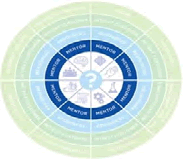 |
Level 2: assigned budget
resources (governance)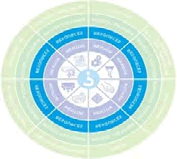 |
Level 3: connect to the market (process)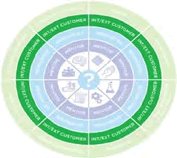 |
Level 4: Connects value chain 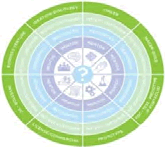 |
|||||
|---|---|---|---|---|---|---|---|---|---|---|
Sector 1: Ideation/Discovery (Design sprints/scrum)  |
 |
Throughout each stage of the design process is there enough high-quality mentorship to support innovators within the organization Culture? (/5)* | Does the organization commit time /money polices to design thinking initiatives for early stage ideas? (/5)* | Does the organization connect the significant value with the internal & external customer at ideation stage? (/5)* | Is the organization structure agile and fast enough to connect business opportunities for early stage investment at idea stage? (/5)* | |||||
Sector 2: Tinkering
(experimentation) 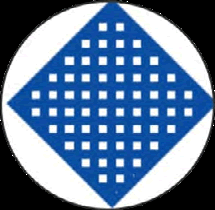 |
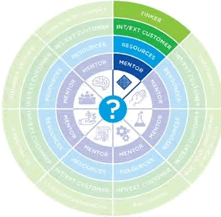 |
Through each stage of the tinkering process is there enough high-quality mentorship to support innovators within the organization? (/5)* | Does the organization commit time /money/space benchmarks to disruptive technology initiatives for tinkering -space Solutions? (/5)* | Does the organization connect the significant value with the internal & external customer at the tinkering stage? (/5)* | Is the organization structure agile and fast enough to connect business opportunities for early stage investment at tinker-stage? (/5)* | |||||
Sector 3: Making
(build/construct)  |
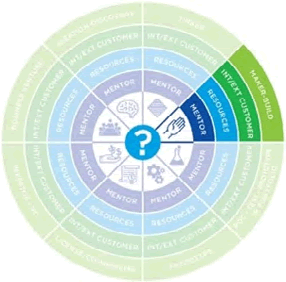 |
Through each stage of the making process is there enough high-quality mentorship to support innovators within the organization? (/5)* | Does the organization commit time /money/space benchmarks to additive manufacturing initiatives for maker-space opportunities? (/5)* | Does the organization connect the significant value with the customer at maker-space stage to predict future innovations? (/5)* | Is the organization structure agile and fast enough to connect business opportunities for early stage investment at maker stage? (/5)* | |||||
Sector 4: Intellectual Property POC/patents, etc.  |
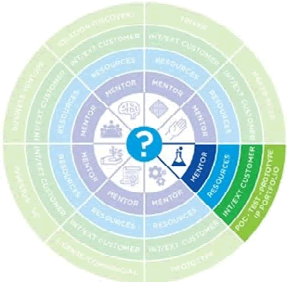 |
Through each stage of the IP process is there enough high- quality mentorship to support innovators within the organization? (/5)* | Does the organization commit time /money/space to invest in patents/trade- mark, company - secrets initiatives for IP? (/5)* | Does the organization connect the significant value with the customer at IP stage for future licensing deals? (/5)* | Is the organization structure agile and fast enough to connect business opportunities for pre-MVP investment at IP stage? (/5)* | |||||
Sector 5: Prototype
(test components) 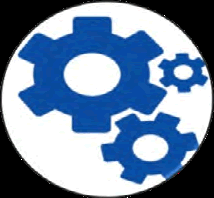 |
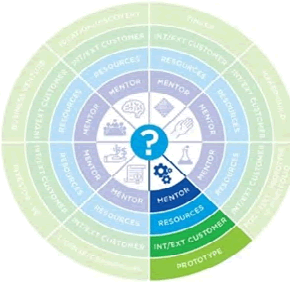 |
Through each stage of the prototype process is there enough high-quality mentorship to support innovators within the organization? (/5)* | Does the organization commit time /money/space benchmarks to invest in prototype initiatives for pre- MVP efforts? (/5)* | Does the organization connect the significant value with the internal & external customer at prototyping stage? (/5)* | Is the organization structure agile enough to connect business opportunities for pre-MVP investment at prototype stage? (/5)* | |||||
Sector 6: Licensing & Commercialization (spinoff)  |
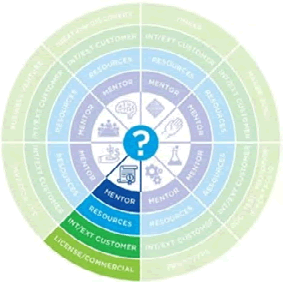 |
Through each stage of the licensing process is there enough high-quality mentorship to support innovators within the organization? (/5)* | Does the organization commit time /money/space to licensing & commercial- ization initiatives (post MVP)? (/5)* | Does the organization connect the significant value with the internal & external customer at comm/license stage? (/5)* | Is the organization structure agile enough to connect business opportunities for mid- stage investment at IP stage? (postMVP) (/5)* | |||||
Sector 7: Venture Capital (Seed fund/Investment) 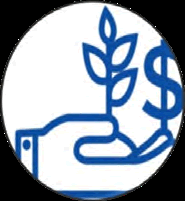 |
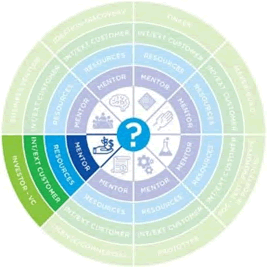 |
Through each stage of the VC process is there enough high- quality mentorship to support innovators within the organization? (/5)* | Does the organization commit money to connect innovation with potential investment – internal and external Interest?? (/5)* | Does the organization connect the significant value with the internal & external customer at VC stage? (/5)* | Is the organization structure agile enough to connect business opportunities for initial investment stage? (/5)* | |||||
Sector 8: Business Venture (Creation of company)  |
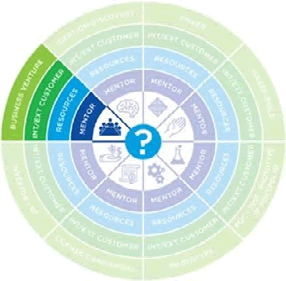 |
Through each stage of the venture process is there enough high-quality mentorship to support innovators within the organization? (/5)* | Does the organization support resources for internal development of venture -builder to be able to create unicorns? (/5)* | Does the organization connect early with the significant value with the internal & external customer at venture stage? (/5)* | Is the organization structure agile enough to connect business to create a business venture builder program to create unicorns across the value chain? (/5)* | |||||
The generic characteristics as described by VUCA world environment
1. Volatility: Where the environmental context (both internal and external) changes at a very rapid pace, however this change is not in a logical or predictable trend or repeatable pattern (e.g. COVID-19 pandemic – the world and the healthcare system were unprepared and did not predict the outcome until it was too late)
2. Uncertainty: Where the environmental context (both internal and external) result in major “disruptive” changes that occur frequently and rapidly. In this environment, the past is not an accurate, and identifying “what will come next” was difficult and very surprising. (e.g. COVID-19 pandemic – the world and the healthcare system were unprepared with the predictor of the future since there were many strains of the virus)
3. Complexity: Where the environmental context (both internal and external) where there are numerous difficult-to-understand causes and mitigating factors involved in a problem. The world took on a very reactive approach (e.g. COVID-19 pandemic – the world and the healthcare system were unprepared with the predictor of the future since there were many strains of the virus)
4. Ambiguity: Where the environmental context (both internal and external) where the causes and the “who, what, where, when, how, and why” behind the things that are happening are unclear and hard to ascertain. (e.g. COVID-19 pandemic the world and the healthcare system were unprepared with the acceptance of the pandemic due to the confusion and often political implications)
Matrix KEY
*(5) Scoring the Sectors:
1. Non-compliant: Nothing exists to support this sector within the organization
2. Average compliance: Something exists to support this sector within the organization but is fragmented (with examples)
3. Good: Demonstrates good support in this sector within the organization but is fragmented (with examples)
4. Very good: Demonstrates 80% compliance in support of this sector systematically within the organization (with examples)
5. High performing: Demonstrates 100% systematic support of this sector within the organization (with case study support)
These key metrics collated in Table 3 provide a deeper understanding on how to develop analytics that assist organizations to establish a baseline scoring system aligned with best practice and develop various thresholds to add into the conceptual algorithm. This will further establish an advanced database to create and consolidate benchmarks. Another important factor is to further research and consolidate how the VUCA environmental context impacts the four organizational dimensions of: culture, governance, process and design.
Considering that all the metrics that are aligned with chapter 3 are now collated and reviewed from the meta-framework this integration requires an updated empirical map resulting as a main outcome from chapter 3. Figure 11 represents this theoretical and empirical growth.
The key lessons from the methodology chapter have provided insights on how to integrate metrics and empirical relationships (A+B+C=D) related to the construction of the ‘Game Changing Innovation Development Ecosystem’ (GIDE). A meta-framework consists of theory, measurement and analysis this is described in Figure 11.
This GIDE highlights the integration of VUCA+SSM+TSI (A+B+C=D) and how each relationship of this critical systems collective has evolved from theory into practice in the development of the ‘eight sector Innovation value chain’ and the algorithm. Considering that the methodology developed the GIDE Meta-Framework the analysis section will focus on each factor of GIDE algorithm and how that translated into business acumen.
The outcomes from the methodology section provide an analytical synthesis of the specific factors that are required to develop the conceptual factor analysis algorithm. Furthermore, to support this thriving development ecosystem there are four key operational verticals that were developed from theory to practice as ‘Action Based Research’ that were successfully developed by exploring the Eight Sector Innovation Value Chain© outcomes these include:
(1) e-Factory: prototyping Minimal Viable Product (MVP) development and deployment lab (n=135)
(2) Weekly incubator to add the market and business intelligence for viable ventures (n=86)
(3) Innovation Professional Certification (IPC)-Eight Sector Innovation Value Chain© (n=434)
(4) Innovation Ecosystem Society (#IES) (n=2912).
This case study (N=3567) demonstrates how investing and sustaining intellectual human capital through collaboration, mentorship, and empowerment is critical for successful innovation within an organization resulting in a continuous flow of feedstock to produce viable ventures from innovative ideas into business value. As a result, from the findings of the Meta-Framework these data help to develop the variables for the factor analysis algorithm as seen in Figure 12. These factors include a synthesis of VUCA+TSI+SSM+Eight Sector Innovation Value Chain©.
In the application of Figure 12 into the Meta-Framework these key findings from the data synthesis and empirical map provides the factors for the conception of the GIDE Factor Analysis Algorithm (Figure 13).
The Eight Sector Innovation Value Chain© is based on the fundamental premise that innovation=invention+commercialization. Therefore, when navigating the eight sectors with the internal enablers of mentorship, internal/external customers/resources demonstrate how these business drivers enable organizations to take great ideas to the market. Whether this analysis is via the lens of a large company or SME/startup it is essential to navigate the eight sectors with the internal stage gates of: mentorship, internal/external customers/resources and how these business drivers from ideation/discovery, tinkering, making, proof of concept patent, prototype, licensing/commercialization, and business venture. Accelerating great ideas to reality by navigating the eight-sector innovation value chain from lab to market. This algorithm combines the independent variable of the total sum of the Eight Sector Innovation Value Chain Model© (score=80) combined with the multiplier of dependent variables of organizational dimensions, consisting of both soft (human) and hard systems (machine).
It is evident that the VUCA world is here to stay and just like the COVID-19 pandemic it took us all by surprise, we recovered and started to rebuild however we really don’t know what is next? The greatest lesson we can learn is to ‘expect the unexpected’ and be ready to embrace and pivot with VUCA. With that said, the GIDE and this body of work is critical for understanding the business and market impact of systematic innovation practice. This significant knowledge contribution to the industry could overtime develop specific baselines and benchmarks as the algorithm is tested across various organizations, industries and geographies. Once the development of statistically significant benchmarks are constructed this could possibly contribute towards a new metric for measuring the effectiveness of innovation within organizations, such as a future ‘Global Innovation Ecosystem Maturity Index’ (GIEMI)?
Revealed by this research it is evident that the workforce at large, are also searching for more compelling and systematic metrics that can create and sustain innovation within organizations. Based upon the research findings, the authors truly believe that innovation is more than a process, and requires a systematic methodology that can truly invest and synergize innovation through the foundational support of a sustainable and robust ecosystem. Credited by local research spanning eight years and through the application of Total Systems Intervention (TSI) and Meta-Framework resulting in the synthesis of a factor analysis algorithm. This algorithm was developed so that organizations can also apply this systematic methodology to position innovation as a business driver and strategic imperative. This algorithm combines the independent variable of the total sum of the Eight Sector Innovation Value Chain Model© (score=80) combined with the multiplier of dependent variables of organizational dimensions, consisting of both soft (human) and hard systems (machine). Therefore, these research outcomes have contributed towards the development of a proposed metric the maturity innovation ecosystem conceptual algorithm which is the business application of GIDE. Furthermore, an action plan based upon validation research, machine learning simulations and industry case studies is the logical progression of this research work. The future research objective is to further investigate how GIDE provides a significant knowledge and business contribution for organizations through conducting baseline measurements and develop benchmarks across organization size, industry and geography.
Wassim Basrawi and Dr. Sarah Ghaleb who continued to support and motivate this ongoing research and the “model of excellence” for innovation and entrepreneurship in KSA. The amazing talent of the design and logistics team: Trish Wuttke, Radhika Vinod, Summer Taha, Layth Odeh, Awais Iqbal, Hawra Dawood, Nouf Al Qarawi and Shoug Al Harbi. Expert Facilitation team: Nigel Brownbill, Adnan Asaly, Randy McClaren and James Lucca.
Journal of Material Sciences & Engineering received 3677 citations as per Google Scholar report